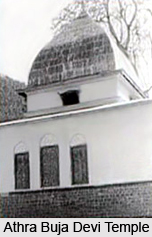 Athra Buja Devi cave temple is about 18km from Kishtwar, the pictorial wooded hill trekking site. Legend speaks of the Goddess Athra Buja who Herself had come to Hari Parbat (Kashmir) and had taken rest in the cave where the present temple stands today. There is a popular belief that Mata Sharika translocates during winter to this temple location. A curious, rather horrific custom of fire dance and fire walk is held in the months of July-August every year, drawing in inquisitive tourists for a look into the strange tradition. Athra Buja Temple is approachable from Kishtwar, 70km northeast of Doda. Jammu Tawi Railway Station is the nearest railhead.
Athra Buja Devi cave temple is about 18km from Kishtwar, the pictorial wooded hill trekking site. Legend speaks of the Goddess Athra Buja who Herself had come to Hari Parbat (Kashmir) and had taken rest in the cave where the present temple stands today. There is a popular belief that Mata Sharika translocates during winter to this temple location. A curious, rather horrific custom of fire dance and fire walk is held in the months of July-August every year, drawing in inquisitive tourists for a look into the strange tradition. Athra Buja Temple is approachable from Kishtwar, 70km northeast of Doda. Jammu Tawi Railway Station is the nearest railhead.
This article is a stub. You can enrich by adding more information to it. Send your Write Up to content@indianetzone.com





















